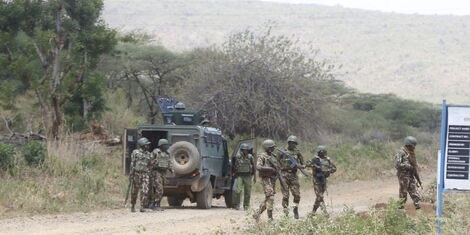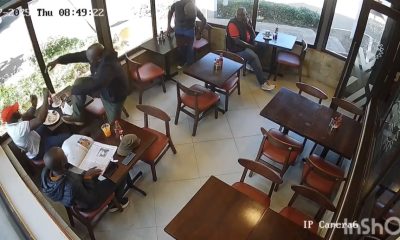News
Inside 48 Hours of Horror in Lamu As IED Explosion Kills 3 KDF and GSU Repulse Al Shabaab Attack

LAMU COUNTY – A deadly 48-hour sequence of terror unfolded in Lamu County this week, culminating in the deaths of three Kenya Defence Forces (KDF) soldiers and leaving a community gripped by fear as al-Shabaab militants stepped up their campaign of violence in the volatile Boni Forest region.
The horror began on Sunday evening when heavily armed al-Shabaab fighters launched a coordinated assault on Milimani village, approximately 80 kilometers from what would become the site of Tuesday’s deadly ambush. The militants attempted to overrun a General Service Unit (GSU) camp and invade the village itself, marking the opening salvo in what security analysts describe as a calculated escalation of terror activities.
Sunday’s Assault: A Village Under Siege
Between 5:45 PM and 6:30 PM on Sunday, the tranquil evening in Milimani was shattered by the sound of automatic gunfire as al-Shabaab fighters emerged from the dense Boni Forest. The militants launched a two-pronged attack, targeting both the GSU camp and the civilian population in what appeared to be a well-coordinated operation.
“There was an attempted raid on the Milimani GSU camp and the village, but we were alert,” said a security officer who requested anonymity due to the sensitive nature of the operation. “The terrorists arrived and started shooting randomly toward the camp and the village.”
The response was swift and decisive. GSU officers, supported by National Police Reservists (NPRs), mounted a coordinated defense that successfully repelled the attackers. The sound of gunfire echoed through the forest as security forces engaged the militants in a fierce firefight that lasted nearly an hour.
For the residents of Milimani, the attack brought back memories of the darkest days of al-Shabaab’s reign of terror in the region. Abdi Ware, a long-time resident, described the panic that gripped the village as families huddled in their homes while bullets flew overhead.
“They shot randomly and everyone stayed inside their homes. They were firing from the forest,” Ware recounted, his voice still carrying the tension of those terrifying moments.
The Deadly Discovery
As dawn broke on Tuesday morning, the true extent of the militants’ preparedness became chillingly apparent. Schoolchildren, venturing out for what should have been a normal day of education, instead stumbled upon a rocket-propelled grenade (RPG) near the village headman’s house. The weapon, believed to have been dropped by fleeing militants during Sunday’s raid, served as a stark reminder that danger lurked just beyond the village boundaries.
The discovery sent shockwaves through the community. Parents, already on edge from Sunday’s attack, quickly alerted security officers who cordoned off the area. The explosive device was safely detonated on Wednesday, but the psychological impact on the community was profound.
“Since the attempted attack on Sunday, we have not been able to go to our farms,” said Mariam Musa, a Milimani resident whose words captured the collective anxiety of the village. “The discovery of the RPG on Tuesday made things worse. Our children have not been attending school due to fear that the militants are still nearby, especially after they killed our KDF soldiers just hours after the RPG was found.”
Tuesday’s Tragic Climax
The sequence of events reached its deadly climax on Tuesday afternoon when the militants struck again, this time along the Sankuri-Kiunga Main Supply Route. A KDF patrol vehicle, conducting routine security operations in the area, hit an improvised explosive device (IED) that had been strategically planted by the militants.
The explosion was devastating. The force of the blast destroyed the vehicle entirely, killing three soldiers instantly and injuring at least six others. The attack, occurring just hours after the RPG discovery in Milimani, appeared to be part of a coordinated campaign designed to maximize both psychological and physical damage.
The timing of the attack was particularly significant. It came as security forces were still processing the implications of Sunday’s assault and the Tuesday morning discovery of the RPG. The militants had effectively kept the region on edge for 48 hours before delivering their most devastating blow.
Lamu County Commissioner Wesley Koech confirmed the attempted raid on Sunday, describing it as a “probing attack” – a military term for operations designed to test the strength and preparedness of a target without launching a full-scale assault.
“There is no cause for alarm. It’s true the device was spotted, but we immediately deployed security personnel to the area and secured it. The matter is under intense investigation,” Koech stated, though his words seemed to ring hollow in the face of Tuesday’s deadly attack.
The commissioner’s characterization of Sunday’s assault as a probing attack has taken on new significance in light of subsequent events. Security analysts suggest that the militants were indeed testing defenses, gathering intelligence, and positioning themselves for the more lethal IED attack that followed.
Operation Amani Boni: The Ongoing Battle
The attacks have prompted an immediate escalation in security operations under Operation Amani Boni, the multi-agency initiative launched in September 2015 to flush out al-Shabaab fighters from the Boni Forest. Originally dubbed Linda Boni, the operation has involved the KDF, National Police Service, and National Government Administration Officers in a sustained campaign against militant activities.
According to military strategic communications, multi-agency teams have ramped up patrols in Sankuri, Badaa, Kiunga, and surrounding villages within and around Boni Forest. Security teams are now closely monitoring all routes in and out of the area in an effort to intercept militants and neutralize remaining threats.
The operation has had significant success over the years, reducing what were once near-weekly militant attacks to sporadic incidents. The Badaa ambush marks the first deadly al-Shabaab attack in Lamu this year, a testament to the effectiveness of sustained security operations in the region.
The 48-hour sequence of events fits into a broader pattern of al-Shabaab activities in the region. Earlier this year, on April 5, militants attempted to storm a GSU camp and a village in Basuba, but the night attack was thwarted by police reservists. The failure of that operation may have contributed to the more sophisticated approach seen in this week’s attacks.
Perhaps most unsettling was an incident on March 15, when over 100 suspected militants stormed Mangai village, assembled residents, preached to them, and handed out dates as Ramadhan gifts. No injuries or deaths were reported, but the incident demonstrated the militants’ ability to operate with apparent impunity in certain areas of the forest.
Both Basuba and Mangai are located within Boni Forest and are home to members of the Boni minority community, highlighting the complex ethnic and geographic dynamics at play in the region’s security challenges.
Beyond the immediate tragedy of three soldiers killed and six injured, the 48-hour sequence of terror has had a profound impact on the civilian population. Schools have closed, farming activities have ceased, and families live in constant fear of the next attack.
The psychological warfare aspect of the militants’ strategy appears to be working. By spacing out their attacks over 48 hours and leaving behind evidence of their presence, they have created a climate of sustained fear that goes far beyond the immediate physical damage of any single incident.
For the residents of Milimani and surrounding communities, the message is clear: the militants can strike at will, they are well-armed and organized, and they are not going away.
As security forces continue their operations in the Boni Forest, the events of this week serve as a stark reminder of the ongoing challenges facing the region. The militants’ ability to coordinate multiple attacks over a 48-hour period, their sophisticated use of IEDs, and their apparent intimate knowledge of the terrain all point to a well-organized and persistent threat.
The government’s commitment to eliminating militant threats in the region remains steadfast, but the events of this week have demonstrated that the fight is far from over. As Commissioner Koech noted, the success of ongoing operations depends heavily on continued cooperation between security forces and local communities.
For now, the residents of Lamu County continue to live under the shadow of terror, hoping that the next 48 hours will bring peace rather than horror to their communities. The three soldiers who died on Tuesday have become the latest casualties in a conflict that has claimed too many lives and shows no signs of ending.
The battle for Lamu continues, and the cost – both human and psychological – continues to mount.
Kenya Insights allows guest blogging, if you want to be published on Kenya’s most authoritative and accurate blog, have an expose, news TIPS, story angles, human interest stories, drop us an email on [email protected] or via Telegram
-

 Investigations2 weeks ago
Investigations2 weeks agoMoney Bior, Lawyer Stephen Ndeda Among 18 Accused Of Running An International Fraud Ring Involved With Scamming American Investor Sh500 Million
-

 Investigations2 weeks ago
Investigations2 weeks agoNestlé Accused of Risking Babies’ Health in Africa with ‘Toxic’ Cerelac Product Sold Highest in Kenya
-

 Investigations1 week ago
Investigations1 week agoHow Land Grabbing Cartels Have Captured Ardhi House
-

 News1 week ago
News1 week ago48-Year-Old Woman Who Pushed 25-Year-Old Boyfriend To Death From 14th Floor Kilimani Apartment Arrested
-

 Investigations2 weeks ago
Investigations2 weeks agoKDC Rocked With Fresh Sh500 Million Tender Scam
-

 Grapevine2 weeks ago
Grapevine2 weeks agoMP Anthony Kibagendi Assault and Injures Kisii Man He Accuses Of Sleeping With One Of His Girlfriends
-

 News2 weeks ago
News2 weeks agoKenyan Man Fighting For Russia Killed On The Frontline Of Ukraine
-

 Business2 weeks ago
Business2 weeks agoHow Dinesh Construction Engaged In Tax Fraud Using ‘Missing Trader’ Scheme

















